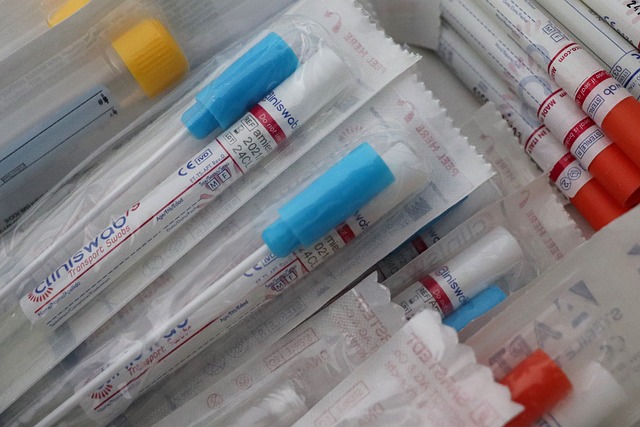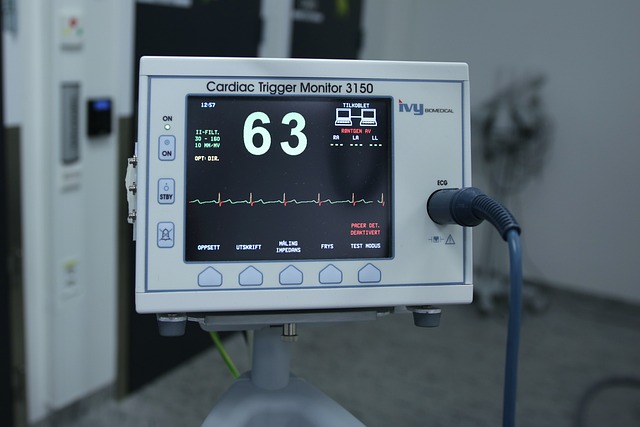The UK's National Health Service (NHS) has a robust system in place to ensure that diagnostic test results are accurately translated and accessible to all patients, regardless of their language proficiency. This is particularly important given the diversity of the UK population. The NHS employs professional translation services for diagnostic test results to overcome linguistic barriers, providing clear and precise translations that help patients understand their medical information fully. These translations are not only linguistically accurate but also consider cultural nuances to prevent misinterpretation. This commitment to high-quality communication is a cornerstone of the NHS's healthcare strategy, aligning with guidelines that prioritize patient care and adherence to the highest standards of medical diagnostics. The integration of translation services enhances patient outcomes, supports informed decision-making by both patients and healthcare professionals, and upholds the inclusive values of UK healthcare. The use of advanced AI and machine learning algorithms is improving the efficiency and accuracy of these translations, ensuring that diagnostic precision remains a key component of patient care in the UK. This investment in translation technology positions the UK's healthcare system as a leader in providing equitable and safe healthcare services to all patients, with a particular focus on those who are non-native English speakers.
navigating the complexities of diagnostic testing within the UK’s National Health Service (NHS) can be pivotal in patient care. This article delves into the intersection where translation services for diagnostic test results play a critical role, ensuring clarity and adherence to guidelines. We will explore the framework governing UK healthcare guidelines for diagnostic testing, highlight the necessity of multilingual communication in this context, and examine case studies where translation services have successfully bridged language barriers. Furthermore, we will discuss future developments and innovations poised to enhance the accuracy of translated diagnostic results, thereby upholding the standards set by the NHS.
- Understanding the Role of Translation Services in Diagnostics within the UK Healthcare System
- The Framework of UK Healthcare Guidelines for Diagnostic Testing
- Accurate Translation of Diagnostic Results: Ensuring Compliance with NHS Protocols
- The Importance of Multilingual Communication in Diagnostic Settings
- Case Studies: How Translation Services Bridge Language Barriers in UK Diagnostics
- Future Developments and Innovations in Translation for Diagnostic Accuracy in the UK
Understanding the Role of Translation Services in Diagnostics within the UK Healthcare System

In the UK’s National Health Service (NHS), the accuracy and clarity of diagnostic test results are paramount for effective patient care. As the NHS serves a diverse population with varying language needs, translation services for diagnostic test results play a critical role in ensuring that healthcare professionals can interpret and communicate these results accurately across linguistic barriers. These services facilitate the precise translation of medical terminology, which is often complex and technical, into the patient’s preferred language. This not only enhances understanding but also compliance with treatment plans. The process is bidirectional, benefiting both non-English speaking patients who receive care in English and English-speaking patients when healthcare providers are multilingual but not fluent in the patient’s language. The integration of translation services into the diagnostic process is a testament to the NHS’s commitment to inclusive healthcare and patient safety. It ensures that no patient is at a disadvantage due to language differences, thereby upholding the high standards of care expected within the UK healthcare guidelines. Moreover, these translations are not mere paraphrases; they undergo rigorous quality control to ensure medical terminology is accurately conveyed, which is essential for maintaining the integrity of clinical decisions and patient outcomes.
The Framework of UK Healthcare Guidelines for Diagnostic Testing

In the United Kingdom, diagnostic testing is governed by a robust and comprehensive framework of healthcare guidelines designed to ensure the highest standards of patient care. These guidelines are informed by extensive research and expert consensus, reflecting the latest scientific evidence and best practices in medical diagnostics. They encompass criteria for selecting appropriate tests, interpreting results, and integrating findings into patient management strategies. This rigorous approach facilitates consistent, high-quality healthcare delivery across different regions and healthcare providers. For instances where communication barriers exist, translation services for diagnostic test results play a pivotal role in the UK’s healthcare system, ensuring that patients who speak different languages can understand their medical reports accurately. These services are integral to the patient-centered care model, bridging language disparities and promoting clear, informed decision-making by both patients and healthcare professionals. The translation of diagnostic results is not merely a matter of linguistic accuracy but also one of cultural sensitivity and appropriate medical terminology to avoid misinterpretation or misunderstanding. Thus, the UK’s healthcare guidelines prioritize accessibility and clarity in communication, making such translation services an essential component of the diagnostic process within the framework established by these guidelines.
Accurate Translation of Diagnostic Results: Ensuring Compliance with NHS Protocols

When it comes to medical diagnostics, the translation of diagnostic test results is a critical step that ensures patients and healthcare providers receive accurate and actionable information. In the UK, the National Health Service (NHS) has established protocols to facilitate this process effectively. These protocols mandate the use of professional translation services for diagnostic test results to be precise and reliable. This is essential as it minimizes the risk of miscommunication or errors that could lead to inappropriate treatment decisions. The translation services employed must not only be linguistically accurate but also medically sound, reflecting an understanding of both medical terminology and the cultural context of the patient’s origin. This dual proficiency is crucial for the correct interpretation of test results, which can then inform the clinical decision-making process in line with NHS guidelines. By adhering to these protocols, healthcare providers in the UK ensure that all patients, regardless of their linguistic background, receive care that meets the high standards set by the NHS, thereby promoting equity and safety in healthcare delivery.
The Importance of Multilingual Communication in Diagnostic Settings

In the context of UK healthcare, effective communication is paramount, and this extends to multilingual settings where patients may not speak English as their first language. The provision of translation services for diagnostic test results in the UK is crucial for accurate interpretation and patient understanding. These services bridge the linguistic gap, ensuring that patients from diverse cultural and linguistic backgrounds can fully comprehend their diagnostic reports, thereby facilitating informed decision-making about their treatment options. This is not only ethically imperative but also aligns with the guidelines set forth by the National Health Service (NHS) for patient care and engagement. The use of professional translation services for diagnostic test results in UK healthcare settings also helps to prevent miscommunication, which could lead to adverse health outcomes or unnecessary interventions. It underscores a commitment to high-quality patient care and respects the rights of patients to receive information in a language they can understand, ultimately promoting better health outcomes and patient satisfaction. Incorporating multilingual communication as a standard practice within diagnostic settings enhances the quality of healthcare delivery and aligns with the inclusive ethos of UK healthcare guidelines.
Case Studies: How Translation Services Bridge Language Barriers in UK Diagnostics

Translation services play a pivotal role in healthcare settings, particularly within the realm of diagnostics in the UK. When patients from diverse linguistic backgrounds undergo diagnostic testing, the accuracy and clarity of the results are paramount. The effectiveness of these translation services is not just about conveying information; it’s about ensuring that medical professionals can interpret the diagnostic test results accurately, regardless of the original language. This is where specialized translation services for diagnostic test results in the UK become indispensable, providing precise and reliable translations that facilitate better patient care and outcomes.
Case studies have consistently demonstrated the impact of these services. For instance, a patient with a non-English first language might receive a diagnosis in their native tongue. The subsequent translation of these diagnostic test results into English enables healthcare providers to make informed decisions without the risk of miscommunication or misunderstanding. Such translations are not merely linguistic equivalents but are contextually accurate and medically relevant, ensuring that the nuances of the original text are preserved. This level of precision is critical in avoiding potential errors that could arise from language barriers, ultimately leading to improved patient safety and satisfaction within the UK healthcare system.
Future Developments and Innovations in Translation for Diagnostic Accuracy in the UK

The United Kingdom’s healthcare system is continuously evolving, with a particular focus on enhancing diagnostic accuracy through the integration of advanced translation services. As global medical knowledge expands and becomes more diverse, there is an increasing need to accurately translate diagnostic test results for patients whose primary language is not English. This is where cutting-edge developments in translation services come into play, offering precise and immediate translations that meet the high standards required in clinical settings. Future developments promise to leverage artificial intelligence and machine learning algorithms to provide real-time, high-fidelity translations, which are critical for accurate diagnosis and patient care. These innovations not only facilitate better communication between healthcare providers and patients but also streamline the process of sharing diagnostic information across multidisciplinary teams and international borders. As such, translation services for diagnostic test results in the UK are set to become a cornerstone of precision medicine, ensuring that all patients receive care tailored to their linguistic needs without compromising on diagnostic quality. The integration of these services into the UK’s healthcare guidelines is a testament to the country’s commitment to inclusivity and excellence in patient care.
In conclusion, the integration of translation services within the UK healthcare system plays a pivotal role in upholding diagnostic testing guidelines. The compliance of these services with NHS protocols ensures that language barriers do not compromise the accuracy and effectiveness of diagnostic results. This aligns with the UK healthcare guidelines that emphasize clear communication across diverse linguistic backgrounds. Case studies highlight the tangible impact of such translational support, illustrating how it enhances patient care without compromising on precision or safety. As we look to the future, advancements in translation technology and services are poised to further streamline diagnostic processes within the UK, offering a more inclusive approach to health management that respects and accommodates cultural and linguistic differences. These developments underscore a commitment to equitable healthcare outcomes, making translation services for diagnostic test results an indispensable aspect of the UK’s medical landscape.



